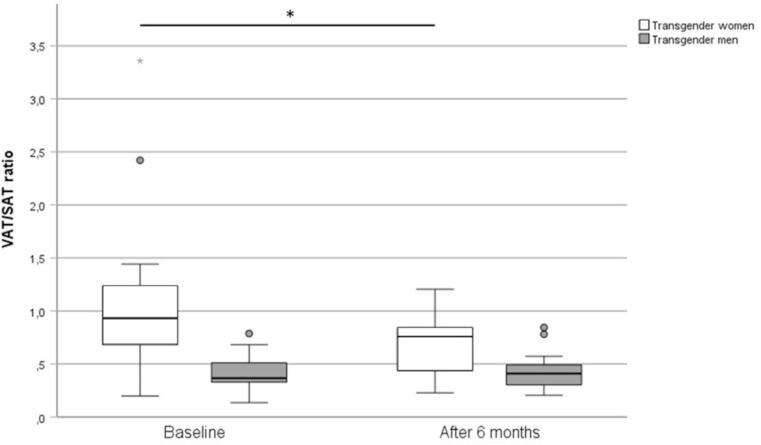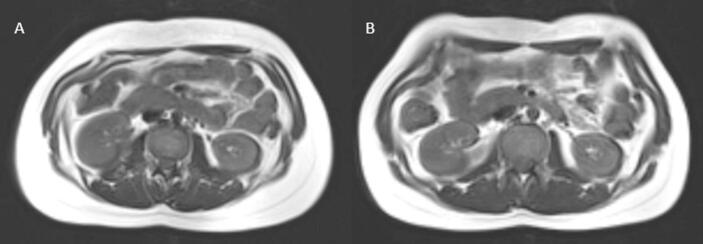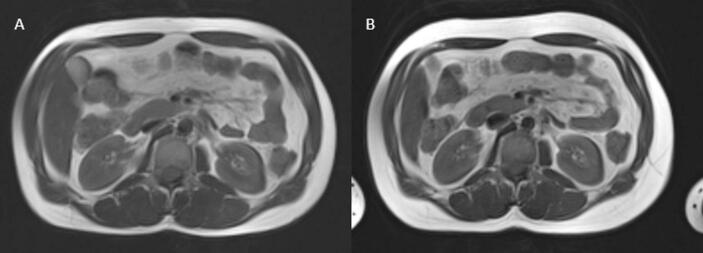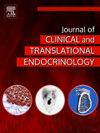性别肯定激素治疗对心肌、肝脏、胰腺脂质含量、体脂分布及其他心脏代谢危险因素的影响:一项基于跨性别个体的磁共振研究
IF 3.3
Q1 ENDOCRINOLOGY & METABOLISM
Journal of Clinical and Translational Endocrinology
Pub Date : 2024-12-06
DOI:10.1016/j.jcte.2024.100379
引用次数: 0
摘要
目的:我们旨在评估跨性别男性(TM)和跨性别女性(TW)在接受性别确认激素治疗(GAHT) 6个月后体脂分布、器官内脂质积累和心脏代谢危险因素的变化。方法:该研究于2019年至2022年在维也纳医科大学进行,包括15名TW和20名TM。我们在基线和GAHT治疗6个月后进行了磁共振成像和光谱学,以确定内脏(VAT)和皮下脂肪组织(SAT)的数量、VAT/SAT比值、器官内脂质含量(肝脏、胰腺、心肌)、血液检查和口服葡萄糖耐量试验。结果:在GAHT治疗6个月后,两组患者的胰腺、肝脏和心肌内脂质含量均无显著变化。在台湾,增值税/SAT比率从基线0,930 (IQR 0,649-1,287)显著下降至0,758 (IQR 0,424-0,900);p = 0.011)。更新后的稳态模型评估胰岛素敏感性(HOMA2-%S)从83,03%(±31,11)显著下降到64,27%(±18,01);p = 0.047),表明胰岛素敏感性降低,而更新的稳态模型评估β-细胞功能(HOMA2-%β)增加(从128,11%(±35,80)增加到156,80%(±39,49);p = 0,020)。在TM中,除了HbA1c升高(5.1%(±0,3)vs 5.3%(±0,4),p = 0.001)外,葡萄糖代谢参数没有变化。结论:6个月的GAHT治疗与心肌、肝脏或胰腺脂质含量的统计学显著变化无关。短期GAHT导致了显著的体脂再分配,在TW中VAT/SAT比值显著降低。本文章由计算机程序翻译,如有差异,请以英文原文为准。



The effects of gender-affirming hormone therapy on myocardial, hepatic, pancreatic lipid content, body fat distribution and other cardiometabolic risk factors: A magnetic resonance-based study in transgender individuals
Purpose
We aimed to assess the changes in body fat distribution, intraorgan lipid accumulation, and cardiometabolic risk factors after 6 months of gender-affirming hormone therapy (GAHT) in transgender men (TM) and transgender women (TW).
Methods
Conducted at the Medical University of Vienna between 2019 and 2022, the study included 15 TW and 20 TM. We conducted magnetic resonance imaging and spectroscopy to determine the visceral (VAT) and subcutaneous adipose tissue (SAT) amounts, the VAT/SAT ratio, and the intraorgan lipid content (liver, pancreas, myocardium), bloodwork, and an oral glucose tolerance test at baseline and after 6 months of GAHT.
Results
Pancreatic, hepatic, and intramyocardial lipid contents did not significantly change in either group after 6 months of GAHT. In TW, VAT/SAT ratio decreased significantly from baseline 0,930 (IQR 0,649–1,287) to 0,758 (IQR 0,424–0,900; p = 0,011) after 6 months of GAHT. The updated homeostatic model assessment for insulin sensitivity (HOMA2-%S) significantly decreased from 83,03 % (±31,11) to 64,27 % (±18,01; p = 0,047), indicating decreased insulin sensitivity, while the updated homeostatic model assessment for β-cell function (HOMA2-%β) increased (from 128,11 % (±35,80) to 156,80 % (±39,49); p = 0,020) in TW after 6 months of GAHT. In TM, there were no changes in glucose metabolism parameters except for an increase in HbA1c (5,1% (±0,3) vs 5,3% (±0,4), p = 0,001).
Conclusions
6 months of GAHT were not associated with statistically significant changes in myocardial, hepatic, or pancreatic lipid content. Short-term GAHT led to a marked body fat redistribution with a significant decrease in the VAT/SAT ratio in TW.
求助全文
通过发布文献求助,成功后即可免费获取论文全文。
去求助
来源期刊

Journal of Clinical and Translational Endocrinology
ENDOCRINOLOGY & METABOLISM-
CiteScore
6.10
自引率
0.00%
发文量
24
审稿时长
16 weeks
 求助内容:
求助内容: 应助结果提醒方式:
应助结果提醒方式:


